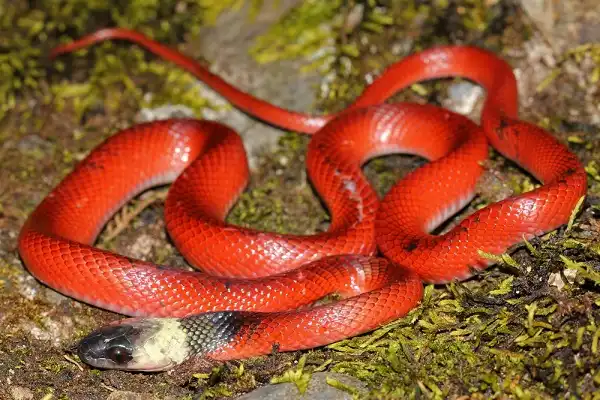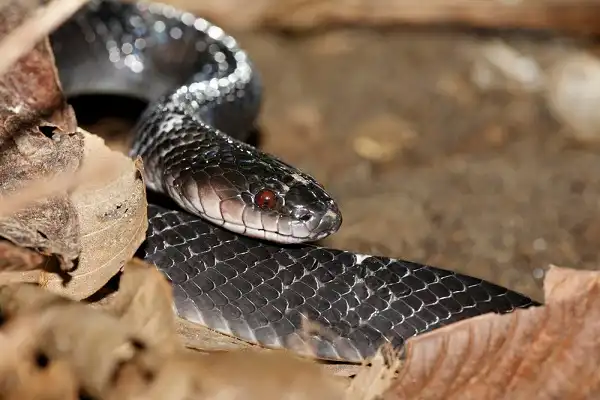Are you looking for a fascinating reptile to keep as a pet? Consider the mussurana snake. This species of Colubrid snake is native to Central and South America and is renowned for its striking colored pattern, graceful form, and ease of keeping. Keep reading to learn more about this captivating species including how to care for them in captivity!

Mussurana Snake Description
The mussurana snake is a fascinating species of Colubrid snake that can be found in Central and South America. This beautiful snake species is admired by many snake enthusiasts for its remarkable color pattern, which consists of alternating stripes of black, brown, and white. In addition to its stunning appearance, the mussurana snake boasts a graceful form that allows it to move swiftly and elegantly through its environment. Mussurana snakes belong to the genus Clelia and are also known as Coraline snakes. The species name of the mussurana is Clelia clelia, and it is a member of the same family as other popular pet snakes like corn snakes and kingsnakes.
Mussurana Snake Habitat
Mussurana snakes are native to Central and South America and can be found in a variety of habitats, ranging from forests and mangrove swamps to grasslands and savannas. They are primarily terrestrial but are also capable of climbing trees and swimming in water. In the wild, mussurana snakes typically live in underground burrows that they excavate themselves, or they use abandoned burrows of other animals. These snakes are known to be solitary creatures and prefer to live alone. However, they do not mind sharing a burrow with a mate during the breeding season.
The habitat of the mussurana snake plays a crucial role in its survival. These snakes require a consistent source of heat to regulate their body temperature because they are ectothermic animals. They often bask in the sun to warm their bodies, which increases their metabolism and digestion. Consequently, they can hunt and catch their prey more effectively. The ideal temperature range for mussurana snakes is between 75 to 85 degrees Fahrenheit. To maintain this temperature range in captivity, the enclosure should be equipped with a heat source such as a heat lamp or heat pad. Additionally, a basking spot with temperatures ranging from 85 to 90 degrees Fahrenheit should be provided to mimic their natural habitat.
Mussurana Snake Diet
The mussurana snake, also known as the coffee snake or Indo-American wolf snake, is a fascinating predator that feeds on a wide variety of prey. In their natural habitat, they primarily consume venomous snakes such as pit vipers and coral snakes. These snakes have developed an immunity to the venom of their prey, making them one of the few animals capable of feeding on these highly toxic creatures. In captivity, mussurana snakes are commonly fed a diet of rodents, birds, and other small prey items. They are not picky eaters and will readily consume a variety of foods. However, it is important to provide them with a balanced and nutritious diet to ensure their overall health and well-being.
Mussurana Snake Size
The mussurana snake, also known as the coffee snake or Indo-American wolf snake, is a medium-sized species that can grow up to 6.5 feet in length. Adult males are typically smaller than females, with an average length of around 5 feet. These snakes are slender and have a light grey or brownish coloration with a dark stripe running down their back. One remarkable characteristic of the mussurana snake is its ability to change in size and shape. The skin on their neck and head is highly flexible, allowing them to inflate and stretch out their body. This unique adaptation allows them to crawl into tight spaces to catch their prey, as well as escape potential predators. Despite their impressive size and strength, mussurana snakes are also known for their docile nature.

Mussurana Snake Lifespan
The mussurana snake is an incredible creature that has continued to captivate researchers and nature enthusiasts alike. It is known for a number of fascinating features, including its impressive size, unique feeding behavior, and ability to inflate its body. One other remarkable characteristic of this species is its lifespan. While exact figures vary, mussurana snakes have been known to live for up to 10 years in the wild, and even longer in captivity. This is a relatively long lifespan compared to many other snake species and is due in part to the mussurana’s ability to adapt to a wide range of environments. Like many snakes, the mussurana is a cold-blooded reptile that relies on external sources of heat to regulate its body temperature.
This means that it is more active in warm weather and requires a cooler environment to hibernate during the winter months. In captivity, mussurana snakes require a carefully controlled environment that mimics their natural habitat, with access to both warmth and coolness as needed. Another factor that can impact the mussurana snake’s lifespan is diet. While these snakes are adaptable and not particularly picky eaters, a balanced and nutritious diet is essential for their long-term health. This includes a variety of prey items that provide the necessary nutrients and vitamins to promote healthy growth and prevent disease.
Mussurana Snake Behavior
The behavior of the Mussurana snake is a subject of great interest among researchers and snake enthusiasts who seek to better understand its unique characteristics. These snakes are docile and rarely aggressive toward humans, but their hunting behavior is one of their most impressive features. One fascinating aspect of Mussurana’s snake behavior is its scavenging behavior. They have a strong sense of smell and can locate carrion from long distances away. They are known to feed on the carcasses of dead animals, which means that they play a critical ecological role in maintaining the balance of ecosystems.
Mussurana snakes are able to camouflage themselves effectively in their surroundings, which allows them to blend in and remain hidden from predators. They also have the ability to inflate and stretch out their body, which enables them to crawl into tight spaces to catch or escape from their prey. Furthermore, Mussurana snakes have a complex social structure. They are not solitary creatures, and they often cohabit in groups, particularly during the mating season. They engage in intricate courtship rituals, which involve a series of physical displays and vocalizations that communicate their reproductive fitness to potential mates.
Mussurana Snake Speed
When it comes to speed, the Mussurana snake is not known for being the fastest snake around. In fact, they are relatively slow-moving creatures that rely on stealth and agility to catch their prey. Their average speed is around 2 to 3 miles per hour, which is considerably slower than other snake species. However, what the Mussurana snake lacks in speed, it more than makes up for in hunting tactics. These snakes are ambush predators that strike quickly and with precision. They are capable of moving rapidly over short distances, which allows them to make swift and unexpected strikes. Their impressive agility comes in handy when hunting in trees, where they are known to move with the greatest of ease. Their muscular bodies enable them to easily cling onto branches and glide through the air to catch their prey. They also have strong gripping abilities, which allow them to grip their prey tightly.

Mussurana Snake Hunting
Mussurana snakes are known for their exceptional hunting skills, which make them formidable predators that strike fear into their prey. Their hunting tactics involve a combination of agility, speed, and precision strikes that enable them to capture a wide range of animals both on the ground and in trees. Their hunting method is primarily ambush-based, which means they wait for their prey to come to them. They strike with lightning speed, taking their prey by surprise and immobilizing them with their powerful jaws. Their ability to strike and capture prey in a single movement is an awe-inspiring feat that leaves many animal enthusiasts mesmerized. Mussurana snakes have an exceptional sense of smell, which they use to search for carrion and other dead animals. This scavenging behavior is an important ecological function, as it helps to maintain the balance of ecosystems.
The fact that Mussurana snakes can detect the scent of carrion from long distances away emphasizes their highly developed sense of smell and their ability to locate food sources in even the most challenging environments. Their prowess in hunting can be attributed to their remarkable physical attributes. They are highly agile creatures that can move with great speed and accuracy over short distances. They are able to squeeze their way into tight spaces to catch their prey, displaying their impressive maneuverability. In addition to their hunting capabilities, Mussurana snakes also possess unique sensory organs that allow them to navigate their environment effectively. They have a pit organ located between their eyes and nostrils, which they use to detect heat from their surroundings. This enables them to distinguish between prey and other objects in their environment based on their body temperature.
Mussurana Snake Interactions with Humans
The mussurana snake is rarely seen by humans, as they are shy and reclusive reptiles that prefer to live in thick vegetation away from people. However, these snakes will sometimes come into contact with humans when they venture out of their homes to hunt or feed. Because the mussurana is venomous, humans should be cautious if they encounter this species in the wild. It is best to keep your distance and avoid provoking the animal. If bitten by a mussurana snake, immediate medical attention should be sought in order to prevent serious health complications from occurring. Though it may not seem like it at first glance, the mussurana snake can actually be beneficial for humans. The species helps keep rodent populations under control, which can be beneficial for agricultural and urban areas. They also offer valuable insights into the world of reptiles, helping us better understand their behavior and ecology.
Mussurana Snake Reproduction
Mussurana snakes reproduce sexually, with the female laying eggs that hatch in approximately two months. The snakes reach sexual maturity at about two years of age and typically breed during the rainy season, which is usually between April and June. The female snake lays her eggs on the ground or inside hollow logs or other protected areas such as rotten stumps or animal burrows. The female will lay up to 15 eggs per clutch and these eggs incubate for around two months before hatching. Once hatched, the baby mussurana snakes are independent and must care for themselves. This species is known to mate promiscuously, meaning that both males and females may have multiple partners when breeding each season. This helps ensure that the snakes have strong and diverse gene pools, which can help them adapt to changing environments.

Conclusion
The Mussurana snake is a captivating creature with unique abilities that enable it to be successful in its environment. Its combination of speed, agility, strength, and precision strikes make them formidable hunters that can easily overpower their prey. They are also highly intelligent creatures with an impressive sense of smell and heat-sensing organs that help them locate food sources even in the most inhospitable environments. The Mussurana snake’s hunting prowess and remarkable physical attributes continue to captivate researchers and animal enthusiasts alike, as they seek to learn more about this fascinating species.
Frequently Asked Question

